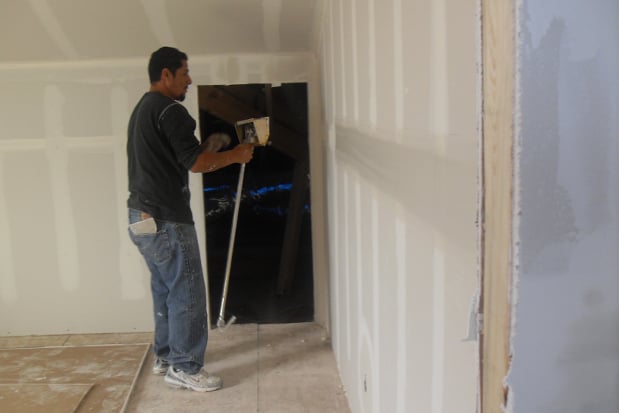
It’s been called many different things—sheetrock, gypsum board, wallboard, and, of course, drywall. However, all these terms refer to the same thing: a panel consisting of a gypsum core surrounded by paper backings. It’s become the most popular form of wall surfacing, quickly replacing the plaster found in older homes. Why? Because it’s cheaper, lighter, and easier to install. Plus, it’s not as hard as plaster, so it won’t crack as fast, but it’s also stronger: it tends to hold objects (such as picture frames) without special hanging devices. Though it’s everywhere you look, this material may still be a mystery to homeowners. Therefore, here are some basics from the very start to its final finish.
How Do You Choose an Appropriate Panel?
Sheetrock comes in 8-10′ panels that are typically a half-inch in width, though it may be a bit thicker (5/8″) for ceilings, garages, or basements. Since it’s constructed of paper, it can be vulnerable to moisture damage, so for wet areas of the house you may want to invest in green board: it’s water-resistant and can withstand high levels of humidity. You can even buy cement board, which is much more resistant to dampness. So make sure when you contact the contractor that you give them a good idea about the size of the space and its location in the home so they know which material to select and how much to use.
Skeletal Structure: Wood or Metal Studs?
Once the panels are selected it’s now time to hang them up. But what do they hang on? In other words, where to do walls come from? Before installing gypsum board, a wall frame must be erected. Though it’s eventually covered up with sheetrock, framing is the most important step in the process, so the materials you select are just as critical.
- Wood Studs: Wood is the more popular framing material since it’s sturdier and less expensive. Plus, it doesn’t transfer energy and therefore creates a better insulator than steel products. But the main reason it’s used so often is due to its easy installation: most contractors are used to working with lumber and therefore it is the preferred method.
- Metal Studs: However, steel materials come with their own benefits when compared to wood. Steel won’t age, warp, rot, or deteriorate. It’s impenetrable against termites, ants, and other pests. It’s fire-proof and flexible, which means it won’t fall apart during earthquakes. Also, during installation, it’s light and forgiving: since it’s simply screwed together, if a mistake is made it’s easily corrected without wasting materials. Plus, it’s environmentally friendly when it comes to saving our natural resources.
Ready to start your drywall project?
Find ProsFinal Finishes: Textured Drywall or Smooth Drywall?
Once the panels are nailed or screwed to the framing, the wall is complete. However, you don’t want to be stuck with an ugly gray façade. So it’s time to finish things up. The joints between the panels will be covered with tape or compound. Also, you’ll have to prepare the surface for decoration. Depending on whether you want wallpaper, paint, or special faux finishes, you must create either textured drywall or smooth drywall.
- Textured Drywall: Textured drywall ranges from light to heavy, with both simple and complex grains. A sprayed texture is the most popular application method since it uses less labor and isn’t as costly as hand-applied finishes. Fine to coarse grades of texture can be sprayed and left in place or quickly flattened with a hand trowel (“knock down” style). But textured drywall can be made coarser by adding granules (of foam, for instance) to the compound or paint.
- Smooth Drywall: There are two types of flat wall finish: for wallpaper (a layer of joint compound is applied and sanded) and for paint (which leaves a slight pebble finish). Many faux painting effects require a smoother finish as well.
- Unfinished Sheetrock: Most people elect to keep their walls unfinished in garages or other work areas since the look isn’t as important and it saves on expenses.
If you are matching existing drywall and having it professionally installed, it’s important to let your service professional know the size and surface type so a more accurate estimate can be delivered. Most contractors bid on the installation by the area, and they often charge more for any specialty finishes. So always be aware of all options available to you and ask for finish samples to avoid accidental surprises with the complete project.
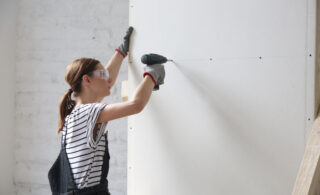 Nails or Screws for Hanging Drywall: Which Works Better?
Nails or Screws for Hanging Drywall: Which Works Better? 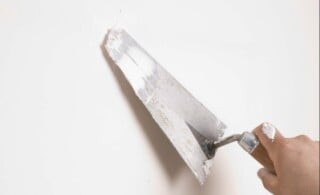 How to Patch Drywall & Fill Cracks
How to Patch Drywall & Fill Cracks 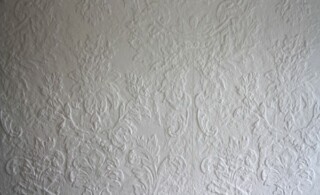 Drywall Texturing Methods
Drywall Texturing Methods 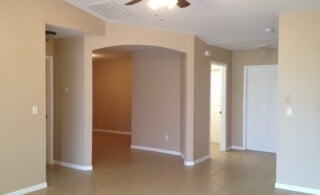 Drywall Installation Techniques
Drywall Installation Techniques 

I have a kitchen that was patched after remodeling. It is an area of 13×13 that needs to have to be re-skimcoated and textured to match the rest of the area.